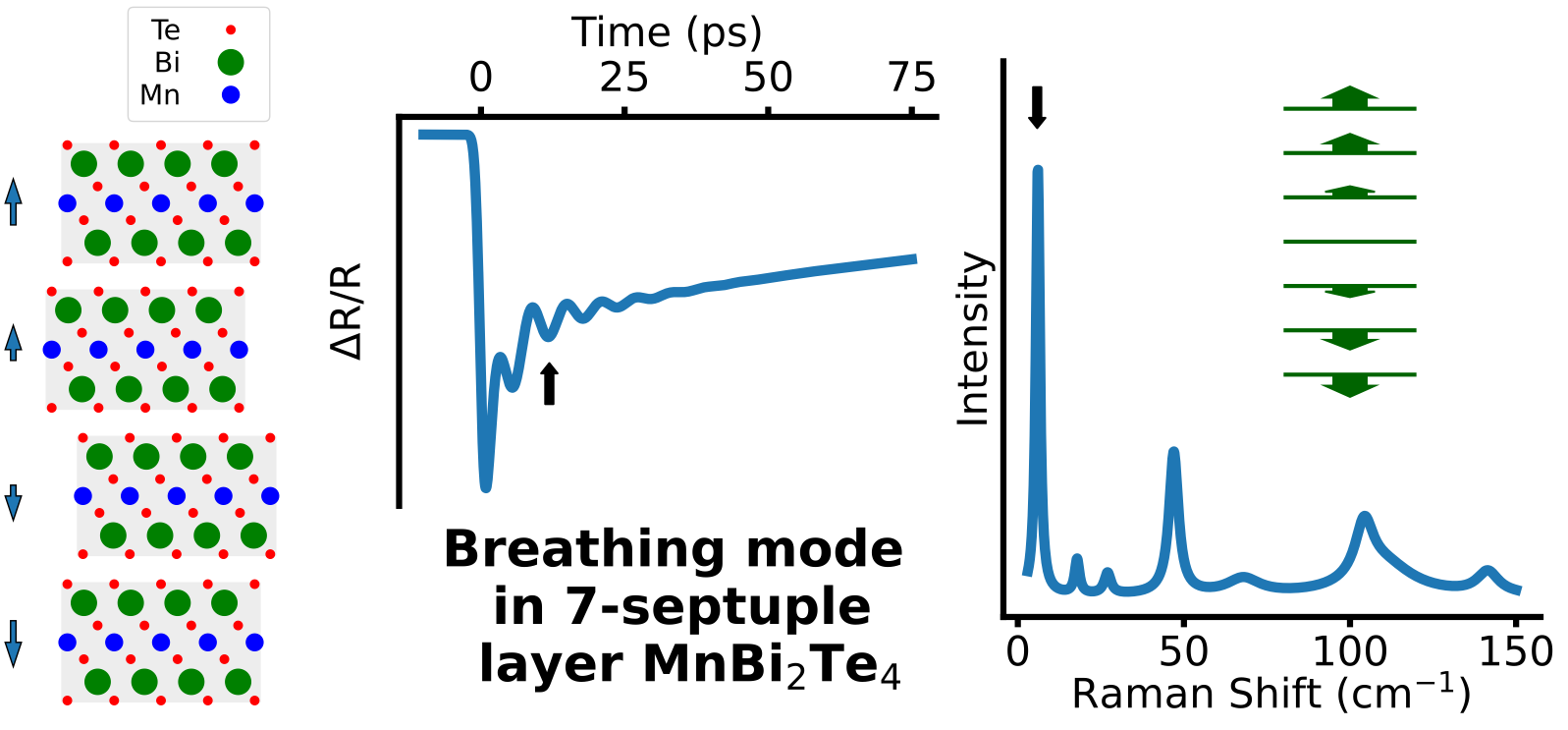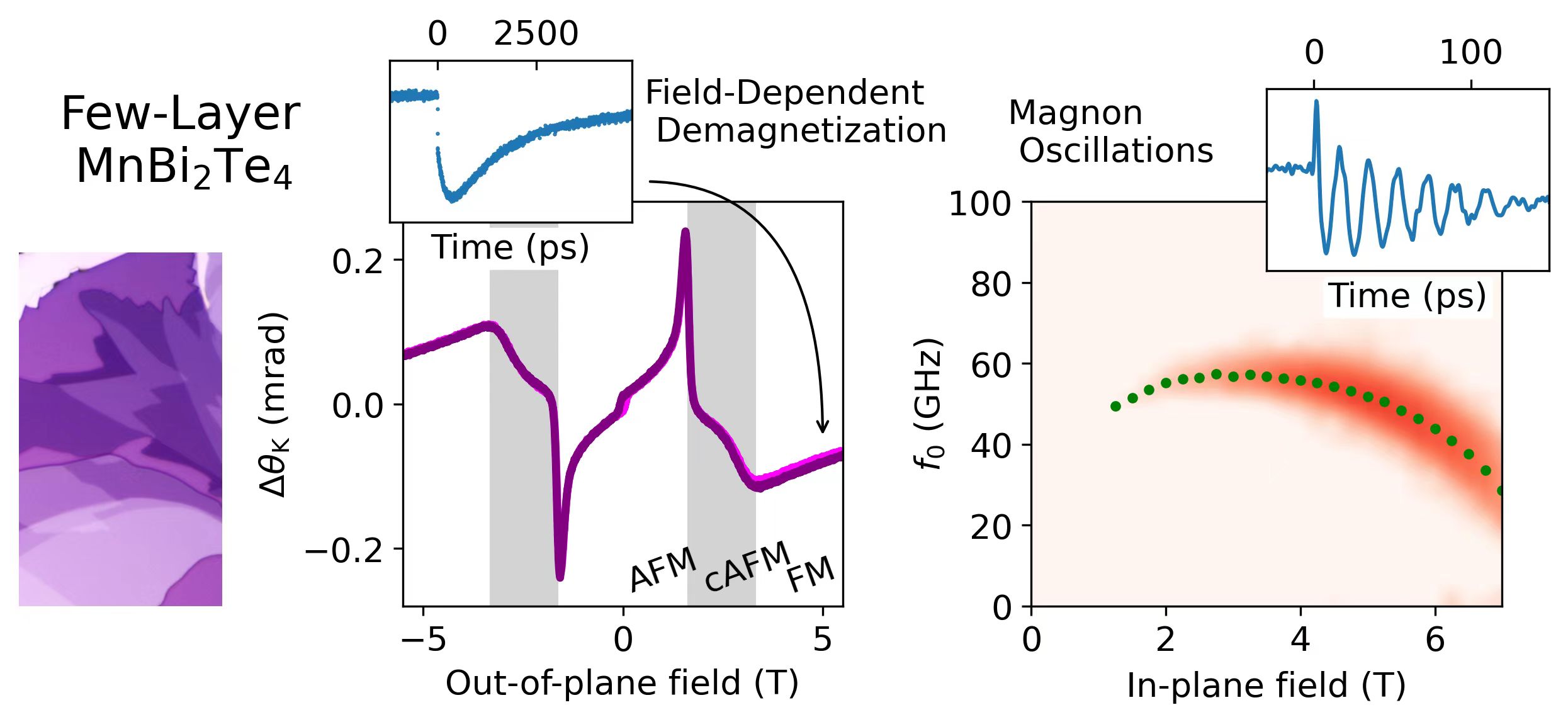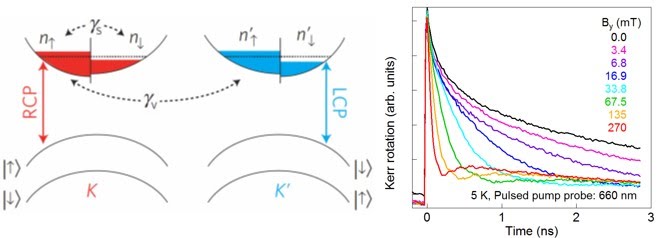Research Topics
Low-energy collective excitations in a two-dimensional antiferromagnet MnBi2Te4
The marriage between topology and magnetism can give birth to many exotic quantum phases and phenomena such as quantum anomalous Hall effect and axion electrodynamics. Recently, few-layer MnBi2Te4 crystals have emerged as a new platform for exploring these phases. We study ultrafast dynamics of low-energy collective excitations in this new class of two-dimensional (2D) topological magnetic material.
1. Ultrafast coherent interlayer phonon dynamics
In 2D van der Waals (vdW) materials, lattice vibrations, especially interlayer phonon modes, have not only provided unique capabilities in determining layer thickness, stacking order, and interface coupling strength, but have also played an important role in engineering novel electronic, thermal and magnetic properties in 2D vdW homo/heterostructures.
In this work, we report ultrafast optical pump-probe reflectivity measurements in few-layer MnBi2Te4, accompanied by ultralow frequency Raman data, of carrier and coherent interlayer phonon dynamics as a function of sample thickness, with the layer number varying from 4 to 25. Pronounced coherent phonon oscillations from the interlayer breathing mode are directly observed in the time domain. We find that the coherent oscillation frequency (50-300 GHz), the photocarrier and coherent phonon decay rates all depend sensitively on the sample thickness. The time-resolved measurements are complemented by ultralow-frequency Raman spectroscopy measurements, which both confirm the interlayer breathing mode and additionally enable observation of the interlayer shear mode.

These measurements not only uncover the interlayer coupling strengths but also provide crucial information on coherent phonon and carrier lifetimes and relaxation mechanisms. Our studies also pave the way for future light-driven topological and magnetic orders in few-layer topological magnetic materials, and ultrafast studies of nonequilibrium magnetic dynamics and nonequilibrium axion dynamics.
This work was in collaboration with Profs. Ping-Heng Tan Group (IOS, CAS), Jinsong Zhang Group (Tsinghua), Pu Yu Group (Tsinghua) and Yang Wu Group (Tsinghua).
2. Ultrafast magnetization and coherent magnon dynamics
Atomically thin van der Waals magnetic materials have not only provided a fertile playground to explore basic physics in the two-dimensional limit but also created vast opportunities for novel ultrafast functional devices.
In this work, we systematically investigate ultrafast magnetization dynamics and spin wave dynamics in few-layer topological antiferromagnetic MnBi2Te4 crystals as a function of layer number, temperature, and magnetic field. We observe laser-induced (de)magnetization processes that can be used to accurately track the distinct magnetic states in different magnetic field regimes, including showing clear odd-even layer number effects. In addition, strongly field-dependent antiferromagnetic magnon modes with tens of gigahertz frequencies are optically generated and directly observed in the time domain. Surprisingly, the magnetic state dependence and magnons are observed not only in time-resolved Kerr rotation and but also in time-resolved reflectivity measurements, indicating a strong correlation between the magnetic state and the electronic structure.

These measurements present the first comprehensive overview of ultrafast spin dynamics in this novel 2D antiferromagnet, paving the way for potential applications in 2D antiferromagnetic spintronics and magnonics as well as further studies of ultrafast control of both magnetization and topological quantum states.
This work was in collaboration with Profs. Shuo Yang Group, Yong Xu Group, Jinsong Zhang Group, Pu Yu Group and Yang Wu Group .
References:
1. Ultrafast coherent interlayer phonon dynamics in atomically thin layers of MnBi2Te4.
F. Michael Bartram, Yu-Chen Leng, Yongchao Wang, Liangyang Liu, Xue Chen, Huining Peng, Hao Li, Pu Yu, Yang Wu, Miao-Ling Lin, Jinsong Zhang, Ping-Heng Tan and Luyi Yang*
npj Quantum Materials 7, 84 (2022)
2. Real-time observation of magnetization and magnon dynamics in a two-dimensional antiferromagnet MnBi2Te4.
F. Michael Bartram#, Meng Li#, Liangyang Liu, Zhiming Xu, Yongchao Wang, Mengqian Che, Hao Li, Yang Wu, Yong Xu, Jinsong Zhang, Shuo Yang and Luyi Yang*
Science Bulletin 68, 2734-2742 (2023)
Magneto-optical Kerr effect in ferromagnetic SrRuO3 thin films
SrRuO3 is a canonical spin-orbit coupled ferromagnet, which is of great interest in incorporating magnetic functionality into oxide devices.
1. Control of magnetism by ionic liquid gating in SrRuO3 thin films
In this work, we demonstrated that the magnetic properties in ferromagnetic SrRuO3 thin films can be controlled by ionic liquid gating (ILG). ILG is a cutting-edge technique for accumulating large carrier densities at a surface. However, it is technically challenging to perform optical measurements at cryogenic temperatures with this technique. We overcame all the experimental challenges and did systematic MOKE studies of ionic liquid gated samples. We showed an efficient and reversible control of an exotic ferromagnetic to paramagnetic phase transition via ILG. We envision that electric-field controlled protonation opens up a pathway to explore novel electronic states and material functionalities in protonated material systems. This work was in collaboration with Prof. Pu Yu's group.

2. Anomalous Kerr signals in SrRuO3 thin films
There has been considerable recent activity in understanding the anomalous Hall effect (AHE) in SrRuO3 which exhibits strange “bumps” upon traversing the magnetic hysteresis loop. In particular, a lively debate over the past year on the origin of such “bumps” has led to two alternative explanations: a two-channel model where two distinct magnetic regions occur with slightly different AHE hysteresis loops, or a topological skyrmion model with an additional real space Berry curvature contribution to the Hall effect.
Our work presents the very first observation of a related anomaly in the optical frequency regime (the magneto-optical Kerr signal) for thin films of SrRuO3. In contrast to previous work, our samples (30 nm to 200 nm thick) are far from the ultrathin limit, so the interfacial Dzyaloshinskii-Moriya interaction, skyrmions, and atomic layer inhomogeneities, are not expected to play an important role. Remarkably, even in this regime, we discover bump-like anomalies in the MOKE signal over wide ranges of temperature, magnetic field, and frequencies, while the magnetization exhibits normal square-like hysteresis loops. Significantly, this observation contradicts the well-established lore that the polar Kerr rotation is linearly proportional to the macroscopic magnetization in ferromagnetic thin films. We also provide a concrete and semi-quantitative theoretical explanation of our data which has been lacking thus far for the AHE.
This work was in collaboration with Prof. Pu Yu's group and Prof. Arun Paramekanti's group (UofT).

References:
1. Reversible manipulation of the magnetic state in SrRuO3 through electric-field controlled proton evolution.
Zhuolu Li#, Shengchun Shen#, Zijun Tian#, Kyle Hwangbo#, M. Wang, Y. Wang, F. Michael Bartram, Liqun He, Y. Lyu, Y. Dong, G. Wan, H. Li, N. Lu, J. Zang, H. Zhou, E. Arenholz, Q. He, Luyi Yang*, Weidong Luo* & Pu Yu*
Nature Comm. 11, 184 (2020).
2. Anomalous Kerr effect in SrRuO3 thin films.
F. Michael Bartram#, Sopheak Sorn#, Zhuolu Li#, Kyle Hwangbo, Shengchun Shen, Felix Frontini, Liqun He, Pu Yu*, Arun Paramekanti*, and Luyi Yang*
Phys. Rev. B 102, 140408(R) (2020).
Spin and valley dynamics in atomically-thin semiconductors
The recently-discovered monolayer MoS2 and related atomically-thin transition metal dichalcogenides (TMDs) are analogous to graphene in that they are 2D materials with hexagonal honeycomb structure, but with an extremely important difference:unlike graphene, TMDs possess a semiconductor bandgap. This makes TMDs useful for a variety of opto-electronic applications, including solar applications, light-emitting diodes, and semiconductor electronics, spintronics, and valleytronics. For example, besides the real electron spin, information can also be encoded in the “valley pseudospin”, i.e. whether the electron resides in the K or K’ valley of the materials’ hexagonal Brillouin zone (or, a quantum superposition of K and K’). Although a robust valley degree of freedom in TMDs has been inferred from photoluminescence (PL) experiments, the exploration of spin-valley coupled dynamics and decoherence of resident electrons in electron-doped material is still at a very early stage.
We directly probed the coupled spin and valley dynamics in electron- (or hole-) doped monolayer MoS2 and WSe2 using techniques based on optically-induced Kerr rotation spectroscopy. In contrast to PL studies, these techniques directly probe the spin and valley polarizations of electrons alone (rather than excitons), which can persist long after recombination with photoexcited holes. Using these Kerr-effect methods, we directly and unambiguously measured very long intrinsic electron spin relaxation timescales ns-μs, which is 2-6 orders of magnitude longer than the exciton recombination time. Measurements as a function of applied magnetic fields indicate that electrons ‘see’ a strong effective magnetic field due to the large spin-orbit coupling in these 2D materials, and that electrons undergo rapid intervalley scattering between the K and K’ valleys of the materials’ hexagonal Brillouin zone. Additionally, a long-lived oscillatory signal is observed at lower energies, indicating that some electrons are localized and exhibit robust spin coherence. These studies provide direct insight into the intrinsic physics underpinning spin and valley dynamics of resident electrons in TMDs.

References:
1. Long-lived nanosecond spin relaxation and spin coherence of electrons in monolayer MoS2 and WS2.
Luyi Yang, N. A. Sinitsyn, W. Chen, J. Yuan, J. Zhang, J. Lou, and S. A. Crooker
Nature Physics 11, 830 (2015).
2. Spin coherence and dephasing of localized electrons in monolayer MoS2.
Luyi Yang, W. Chen, K. M. McCreary, B. T. Jonker, J. Lou and S. A. Crooker
Nano Letters 15, 8250 (2015).
3. Gate controlled spin-valley locking of resident carriers in WSe2 monolayers.
P. Dey, Luyi Yang, C. Robert, G. Wang, B. Urbaszek, X. Marie, S. A. Crooker
Phys. Rev. Lett. 119, 137401 (2017).
"Listen" to spin fluctuations
In magnetic systems, fundamental noise can exist in the form of intrinsic and random spin fluctuations. Passively “listening” to these fluctuations using sensitive optical magnetometry forms the basis of spin noise spectroscopy (SNS), wherein dynamic properties about the system (such as relaxation and coherence times) are inferred from the noise alone while in thermal equilibrium. The fluctuation-dissipation theorem supports this approach.
1. Two-color spin noise spectroscopy: Using spin fluctuation correlations to reveal homogeneous linewidths within quantum dot ensembles
Inhomogeneous broadening is ubiquitous in the sciences, occurring whenever a collection of nominally-equivalent constituents differ in, e.g., size, shape, or composition. However, the homogeneous linewidth γh is usually the quantity of interest, since γh reveals coherence times. Unfortunately, γh is generally inaccessible in inhomogenously-broadened ensembles using conventional low-power/linear optical spectroscopic techniques. Single-particle or non-linear methods are typically required. Here we develop a novel low-power technique – two-color spin noise spectroscopy – to reveal the underlying γh of singly-charged (In,Ga)As quantum dots (QD) in an otherwise inhomogeneously-broadened QD ensemble. (Quantum dots are nanometer-scale, “zero-dimensional” materials useful for electronics, photonics, and potential quantum computing applications.)
As the name suggests, two-color spin noise spectroscopy utilizes two different probe lasers to measure spin fluctuations at different wavelengths. Correlations between these two fluctuation signals form the basis for this new methodology. When the two lasers have the same wavelength, they are sensitive to the same quantum dots in the ensemble and their spin fluctuation signals are correlated. In contrast, two lasers that are widely detuned from each other measure different subsets of quantum dots, leading to uncorrelated fluctuations. Measuring the noise correlation versus laser detuning directly reveals the quantum homogeneous linewidth even in the presence of a strong inhomogeneous broadening.

2. Two-color spin noise spectroscopy: Cross-correlation spin noise spectroscopy of interacting multi-component spin systems
Interacting multi-component spin systems are ubiquitous in semiconductor spintronics; e.g. carrier-mediated ferromagnetism in magnetic semiconductors, or electronic spin coupling to nuclear spin baths. Traditionally, inter-species spin interactions are studied by experimental methods that are necessarily perturbative: e.g., by intentionally polarizing or depolarizing one spin species and detecting the response of the other(s).
We show that multi-probe spin noise spectroscopy can reveal interspecies spin-spin interactions – under conditions of strict thermal equilibrium – by cross-correlating the stochastic fluctuation signals exhibited by each of the constituent spin species. As a proof of principle, we compare the results with an experimental study of a well-understood interacting spin system – a mixture of warm Rb and Cs vapors – by applying the two-color spin noise spectroscopy. Noise correlations directly reveal the presence of inter-species spin exchange interactions.
These non-invasive and noise-based techniques also hold promise for studies of correlations in interacting systems, such as coupled quantum dot or nanocrystal systems, or spin interactions in chemical and biological systems. Advanced optical measurement methods combined with effects of magnetic fields and manipulation of spins in solids could lead toward new physics with potential applications in energy security and information processing technology.

References:
1. Two-colour spin noise spectroscopy and fluctuation correlations reveal homogeneous linewidths within quantum-dot ensembles.
Luyi Yang, P. Glasenapp, A. Greilich, D. Reuter, A. D. Wieck, M. Bayer, D. R. Yakovlev, and S. A. Crooker
Nature Comm. 5, 4949 (2014).
2. Cross-correlation spin noise spectroscopy of heterogeneous interacting spin systems.
D. Roy, Luyi Yang, S. A. Crooker, and N. A. Sinitsyn
Sci. Rep. 5, 9573 (2015).
Spin propagation in a two-dimensional electron gas
In this work, we developed a powerful new optical technique, Doppler spin velocimetry, for probing the motion of spin polarization. This technique is capable of resolving displacements of spin polarization at the level of 1 nm on a picosecond time scale. We applied this technique to measure the motion of a current-driven persistent spin helix, which is a spin texture that can be formed in GaAs quantum wells in the presence of spin-orbit coupling. In the experiments a periodic wave of spin is photoinjected into a two-dimensional electron gas (2DEG) drifting under the influence of an in-plane electric field. Transfer of momentum from the propagating electron sea pushes the spin density wave (SDW) along. To measure the resulting velocity, we detected the Doppler shift of light that is diffracted from the SDW.
Measuring the Doppler shift of light from moving SDWs allowed us to report several surprising aspects of the basic physics that underlies spin propagation in a 2DEG. All of these results are highly relevant to the development of spin logic devices – some with quite favourable implications while others pose challenges that need to be faced and overcome. In the latter category, we discovered that coherent spin precession within a propagating SDW is lost at temperatures near 150 K. This finding is critical to understanding why room temperature operation of devices based on electrical gate control of spin current has so far remained elusive. On the favourable side, at all temperatures, electron spin polarization co-propagates with the high-mobility electron sea, even when this requires an unusual form of separation of spin density from photoinjected electron density. Furthermore, although the spin packet co-propagates with the 2DEG, spin diffusion is strongly suppressed by electron-electron interactions, leading to remarkable resistance to diffusive spreading of the drifting pulse of spin polarization.

References:
1. Doppler velocimetry of spin propagation in a two-dimensional electron gas.
Luyi Yang, J. D. Koralek, J. Orenstein, D. R. Tibbetts, J. L. Reno, and M. P. Lilly
Nature Physics 8, 153 (2012).
2. Coherent propagation of spin helices in a quantum-well confined electron gas.
Luyi Yang, J. D. Koralek, J. Orenstein, D. R. Tibbetts, J. L. Reno, and M. P. Lilly
Phys. Rev. Lett. 109, 246603 (2012).
3. Measurement of electron-hole friction in an n-doped GaAs/AlGaAs quantum well using optical transient grating spectroscopy.
Luyi Yang, J. D. Koralek, J. Orenstein, D. R. Tibbetts, J. L. Reno, and M. P. Lilly
Phys. Rev. Lett. 106, 247401 (2011).
4. Random walk approach to spin dynamics in a two-dimensional electron gas with spin-orbit coupling.
Luyi Yang, J. Orenstein, and D.-H. Lee
Phys. Rev. B 82, 155324 (2010).

